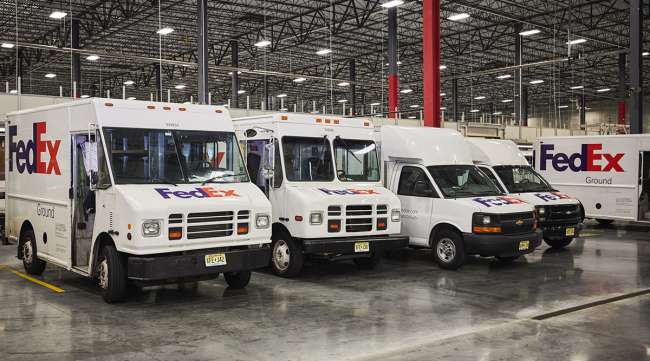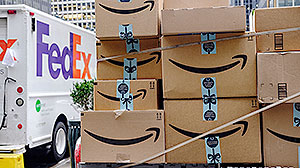Senior Reporter
FedEx’s Q2 Earnings Tumble, Even More Than Wall Street Expected

[Stay on top of transportation news: Get TTNews in your inbox.]
FedEx Corp. reported lower-than-expected second-quarter fiscal 2020 earnings Dec. 17, missing Wall Street analysts’ expectations.
For the quarter ending Nov. 30, the Memphis, Tenn.-based shipping giant reported net income of $560 million, or $2.13 per diluted share, slipping from $935 million, or $3.51, for the same period a year ago.
Quarterly revenue declined to $17.3 billion from $17.8 billion during the same time in 2018.
Analysts had been projecting the company would earn $2.80 a share and have revenue of $17.68 billion, according to Nasdaq.com.
Company officials acknowledged this has been a particularly tough quarter.

Smith
“Fiscal 2020 is a year of continued significant challenges and changes for FedEx, particularly in the quarter just ended due to the compressed shipping season,” CEO Frederick Smith said in a statement. “We have significantly enhanced our e-commerce capabilities with strategic initiatives including year-round, seven-day FedEx Ground delivery, enhanced large package capabilities and the insourcing of FedEx SmartPost packages.
“These changes have been well-received by the marketplace as reflected in our record volumes this peak season. While we have experienced some higher-than-expected expenses this quarter, we forecast FedEx Ground operating margins to rebound to the teens in our fiscal fourth quarter as the bow wave of costs for these changes is absorbed.”
FedEx said operating results declined “due to weak global economic conditions, increased FedEx Ground costs from expanded service offerings, the loss of business from a large customer.”
That large customer is Amazon.com. The relationship between the two giants is deteriorating. Heading into the final holiday push, Amazon announced Dec. 15 it was blocking its third-party sellers from using FedEx Ground and Home services for Amazon Prime deliveries because Amazon said there had been a decline in FedEx’s performance.
Amazon said the ban on using FedEx would continue until FedEx’s performance improves. In a statement, FedEx said of Amazon’s latest decision, “The overall impact to our business is minuscule.”
This summer, Amazon and FedEx ended a long-standing business relationship. FedEx announced in June that it wouldn’t renew a U.S. air-shipping deal with Amazon, then it said in August that a ground-delivery contract won’t be renewed when it expires. FedEx still will have a contract with Amazon for international deliveries.

(Christopher Lee/Bloomberg)
It is estimated FedEx handled about 4% of Amazon’s volume, with Atlanta-based UPS Inc. moving an estimated 17% and the U.S. Postal Service about 33%. Financial analysts believe Amazon will be able to handle about 45% of its own volume this year as it plows investment into sorting hubs, delivery stations and support for contract drivers.
On a conference call with reporters and financial analysts after the company reported its quarterly figures, officials were blunt in their disappointment about the numbers.
“We are disappointed with our current results,” Chief Financial Officer Alan Graf said, “but we are optimistic our long-term performance will benefit from an increased focus on revenue quality.”
The company said there are several reasons for the results.
Costs have been higher than expected as FedEx ramps up its seven-days-a-week delivery operation that officially kicks off Jan. 1. The company is running seven days a week during the holiday season.
FedEx said because Thanksgiving was Nov. 28, that meant the start of the holiday shopping season was compressed by as much as a week. The company said that put more pressure on its delivery system.
“When we went into the peak season … we had an unbelievable response. We had 37 million packages on Cyber Monday and our plan was for 33 million,” Smith said.
Even without Amazon, FedEx officials insist their business plan is moving forward, expanding the business-to-business delivery network and developing relationships with more companies that now are emphasizing e-commerce, instead of traditional brick-and-mortar sales.
FedEx officials also insist they are encouraged the overall economic impact became clearer last week when Washington and Beijing announced the first phase of a trade agreement, which has the potential to reduce tariffs.
“The latest developments on trade are positive, but uncertainty remains. The avoidance of tariffs on approximately $160 billion of goods, scheduled for Dec. 15, and the reduction of tariffs in the Sept. 1 list on $120 billion from 15% to 7.5% is, in fact, good news,” Chief Marketing Officer Brie Carere said on the call. “We look forward to continued progress and the signing of a Phase One deal in January.”
FedEx ranks No. 2 on the Transport Topics Top 100 list of the largest for-hire carriers in North America. UPS ranks No. 1.
Want more news? Listen to today's daily briefing:




